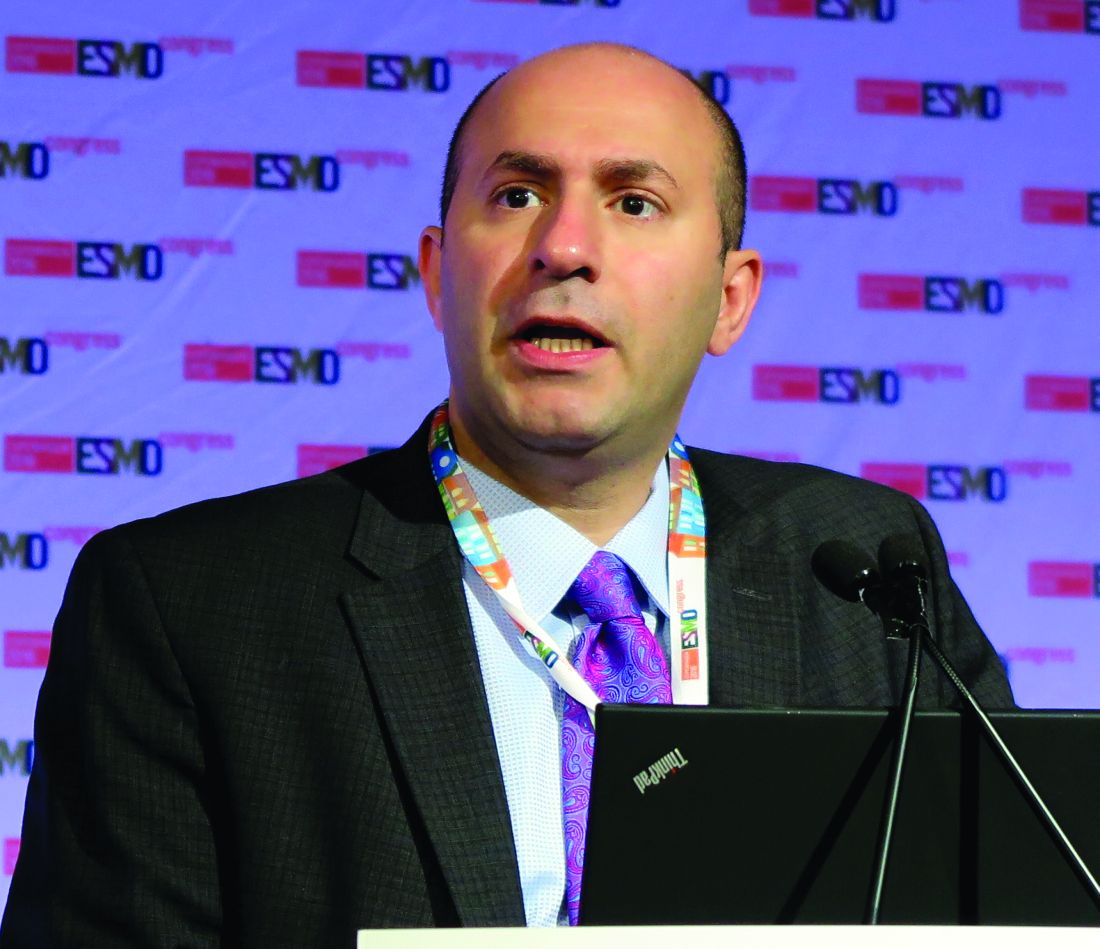User login
COPENHAGEN – For patients with previously untreated intermediate- or poor-risk renal cell carcinoma (RCC), cabozantanib offers a progression-free survival benefit better than that seen with sunitinib, the current standard of care, reported investigators in the phase II CABOSUN trial.
After a median follow-up of 20.8 months, progression-free survival (PFS) for patients assigned to cabozantinib (Canbometyx) the primary endpoint, was a median 8.2 months, compared with 5.6 months for patients assigned to sunitinib, reported Toni K. Choueiri, MD, from the Dana-Farber Cancer Institute in Boston.
“Cabozantinib represents a potential new treatment option for patients with untreated renal cell carcinoma,” Dr. Choueiri said at the European Society for Medical Oncology (ESMO) congress.
Sunitinib (Sutent), a vascular endothelial growth factor receptor (VEGFR) tyrosine kinase inhibitor (TKI) is the standard first-line therapy for patients who present with metastatic RCC. But patients with intermediate- or poor-risk metastatic RCC have shorter survival on sunitinib compared with patients with favorable-risk disease, Dr. Choueiri noted.
Resistance to VEGFR inhibitors in clear-cell RCC can arise through inactivation of the Von Hippel-Lindau (VHL) gene, which leads to upregulation of MET, AXL, and VEGF receptors.
Increased expression of MET and AXL has been associated with resistant to VEGFR inhibitors and poor clinical outcomes, he explained.
Cabozantib is an oral small-molecular inhibitor of multiple tyrosine kinases, including VEGF receptors, MET, and AXL. It is approved in the United States and Europe for use in the second-line setting following prior therapy with a VEGFR inhibitor.
Trial details
In the CABOSUN trial, 157 treatment-naive patients with clear-cell RCC with measurable disease, Eastern Cooperative Oncology Group performance status 0-2 and intermediate- or poor-risk disease according to International Metastatic Renal Cell Carcinoma Database (IMDC) criteria were randomly assigned to receive either oral cabaozantinib 60 mg daily for 6 week cycles, or oral sunitinib 50 mg daily on a standard schedule of 4 weeks on and 2 weeks off.
Tumors were assessed according to Response Evaluation Criteria in Solid Tumors (RECIST) every other cycle, and treatment was continued to the point of disease progression or intolerable toxicity.
A total of 79 patients were assigned to cabozantinib, 78 received it, and 13 were still on the drug at the time of the data cutoff. In all, 78 patients were assigned to sunitinib, 72 received it, and 2 were continuing treatment at last follow-up. The efficacy analysis was by intention-to-treat, and the safety analysis as-treated.
As noted, median PFS was 8.2.months for cabozantinib vs. 5.6 months for sunitinib, The hazard ratio for cabozatinib was 0.69 (P = .012). A subgroup analysis showed a trend favoring cabozantinib in each risk group, but this was not significant except among patients with bone metastases (HR, 0.51; 95% confidence interval, 0.29-0.90).
The overall response rate among patients on cabozantib was 46%, compared with 18% for sunitinib. Complete responses were seen in one patient in each group, partial responses in 35 and 13, respectively, stable disease in 26 and 28, and disease progression in 14 and 20 (data on 3 and 16 patients were not evaluable).
The overall survival analysis hinted at a benefit for cabozantinib (HR, 0.80), but this was not statistically significant.
All cause grade 3 or 4 adverse events occurred in 65% of patients in the cabozantinib arm and 68% in the sunitinib arm. Events occurring more frequently with cabozantinib were hypertension (28% vs. 22%), elevated alanine aminotranseferase (5% vs. 0%), anorexia (5% vs. 0%), palmar-plantar erythrodysethesia (8% vs. 4%), and weight loss (4% vs. 0%).
There were 3 deaths possibly, probably, or definitely related to treatment among 3 patients on cabozantinib and 2 on sunitinib.
Favorable data, but wait and see
“I think cabozantinib is superior to sunitinib in poor and intermediate risk metastatic renal cell cancer,” said invited discussant Bernard Escudier, MD, from the Gustave Roussy Cancer Center in Paris.
“Cabozantinib is a potent VEGF inhibitor and is probably also active in good risk patients, although we need to see the data in these patients,” he said.
He added that a phase 3 study is warranted to confirm these conclusions, and that he will likely wait until those data are available before moving patients to cabozantinib in the first line.
The trial was supported by the National Cancer Institute. Dr. Choueiri disclosed advising and institutional research funding from Exelixis, maker of cabozantinib, and Pfizer, maker of sunitinib. Dr. Escudier disclosed receiving honoraria from each company.
op@frontlinemedcom.com
COPENHAGEN – For patients with previously untreated intermediate- or poor-risk renal cell carcinoma (RCC), cabozantanib offers a progression-free survival benefit better than that seen with sunitinib, the current standard of care, reported investigators in the phase II CABOSUN trial.
After a median follow-up of 20.8 months, progression-free survival (PFS) for patients assigned to cabozantinib (Canbometyx) the primary endpoint, was a median 8.2 months, compared with 5.6 months for patients assigned to sunitinib, reported Toni K. Choueiri, MD, from the Dana-Farber Cancer Institute in Boston.
“Cabozantinib represents a potential new treatment option for patients with untreated renal cell carcinoma,” Dr. Choueiri said at the European Society for Medical Oncology (ESMO) congress.
Sunitinib (Sutent), a vascular endothelial growth factor receptor (VEGFR) tyrosine kinase inhibitor (TKI) is the standard first-line therapy for patients who present with metastatic RCC. But patients with intermediate- or poor-risk metastatic RCC have shorter survival on sunitinib compared with patients with favorable-risk disease, Dr. Choueiri noted.
Resistance to VEGFR inhibitors in clear-cell RCC can arise through inactivation of the Von Hippel-Lindau (VHL) gene, which leads to upregulation of MET, AXL, and VEGF receptors.
Increased expression of MET and AXL has been associated with resistant to VEGFR inhibitors and poor clinical outcomes, he explained.
Cabozantib is an oral small-molecular inhibitor of multiple tyrosine kinases, including VEGF receptors, MET, and AXL. It is approved in the United States and Europe for use in the second-line setting following prior therapy with a VEGFR inhibitor.
Trial details
In the CABOSUN trial, 157 treatment-naive patients with clear-cell RCC with measurable disease, Eastern Cooperative Oncology Group performance status 0-2 and intermediate- or poor-risk disease according to International Metastatic Renal Cell Carcinoma Database (IMDC) criteria were randomly assigned to receive either oral cabaozantinib 60 mg daily for 6 week cycles, or oral sunitinib 50 mg daily on a standard schedule of 4 weeks on and 2 weeks off.
Tumors were assessed according to Response Evaluation Criteria in Solid Tumors (RECIST) every other cycle, and treatment was continued to the point of disease progression or intolerable toxicity.
A total of 79 patients were assigned to cabozantinib, 78 received it, and 13 were still on the drug at the time of the data cutoff. In all, 78 patients were assigned to sunitinib, 72 received it, and 2 were continuing treatment at last follow-up. The efficacy analysis was by intention-to-treat, and the safety analysis as-treated.
As noted, median PFS was 8.2.months for cabozantinib vs. 5.6 months for sunitinib, The hazard ratio for cabozatinib was 0.69 (P = .012). A subgroup analysis showed a trend favoring cabozantinib in each risk group, but this was not significant except among patients with bone metastases (HR, 0.51; 95% confidence interval, 0.29-0.90).
The overall response rate among patients on cabozantib was 46%, compared with 18% for sunitinib. Complete responses were seen in one patient in each group, partial responses in 35 and 13, respectively, stable disease in 26 and 28, and disease progression in 14 and 20 (data on 3 and 16 patients were not evaluable).
The overall survival analysis hinted at a benefit for cabozantinib (HR, 0.80), but this was not statistically significant.
All cause grade 3 or 4 adverse events occurred in 65% of patients in the cabozantinib arm and 68% in the sunitinib arm. Events occurring more frequently with cabozantinib were hypertension (28% vs. 22%), elevated alanine aminotranseferase (5% vs. 0%), anorexia (5% vs. 0%), palmar-plantar erythrodysethesia (8% vs. 4%), and weight loss (4% vs. 0%).
There were 3 deaths possibly, probably, or definitely related to treatment among 3 patients on cabozantinib and 2 on sunitinib.
Favorable data, but wait and see
“I think cabozantinib is superior to sunitinib in poor and intermediate risk metastatic renal cell cancer,” said invited discussant Bernard Escudier, MD, from the Gustave Roussy Cancer Center in Paris.
“Cabozantinib is a potent VEGF inhibitor and is probably also active in good risk patients, although we need to see the data in these patients,” he said.
He added that a phase 3 study is warranted to confirm these conclusions, and that he will likely wait until those data are available before moving patients to cabozantinib in the first line.
The trial was supported by the National Cancer Institute. Dr. Choueiri disclosed advising and institutional research funding from Exelixis, maker of cabozantinib, and Pfizer, maker of sunitinib. Dr. Escudier disclosed receiving honoraria from each company.
op@frontlinemedcom.com
COPENHAGEN – For patients with previously untreated intermediate- or poor-risk renal cell carcinoma (RCC), cabozantanib offers a progression-free survival benefit better than that seen with sunitinib, the current standard of care, reported investigators in the phase II CABOSUN trial.
After a median follow-up of 20.8 months, progression-free survival (PFS) for patients assigned to cabozantinib (Canbometyx) the primary endpoint, was a median 8.2 months, compared with 5.6 months for patients assigned to sunitinib, reported Toni K. Choueiri, MD, from the Dana-Farber Cancer Institute in Boston.
“Cabozantinib represents a potential new treatment option for patients with untreated renal cell carcinoma,” Dr. Choueiri said at the European Society for Medical Oncology (ESMO) congress.
Sunitinib (Sutent), a vascular endothelial growth factor receptor (VEGFR) tyrosine kinase inhibitor (TKI) is the standard first-line therapy for patients who present with metastatic RCC. But patients with intermediate- or poor-risk metastatic RCC have shorter survival on sunitinib compared with patients with favorable-risk disease, Dr. Choueiri noted.
Resistance to VEGFR inhibitors in clear-cell RCC can arise through inactivation of the Von Hippel-Lindau (VHL) gene, which leads to upregulation of MET, AXL, and VEGF receptors.
Increased expression of MET and AXL has been associated with resistant to VEGFR inhibitors and poor clinical outcomes, he explained.
Cabozantib is an oral small-molecular inhibitor of multiple tyrosine kinases, including VEGF receptors, MET, and AXL. It is approved in the United States and Europe for use in the second-line setting following prior therapy with a VEGFR inhibitor.
Trial details
In the CABOSUN trial, 157 treatment-naive patients with clear-cell RCC with measurable disease, Eastern Cooperative Oncology Group performance status 0-2 and intermediate- or poor-risk disease according to International Metastatic Renal Cell Carcinoma Database (IMDC) criteria were randomly assigned to receive either oral cabaozantinib 60 mg daily for 6 week cycles, or oral sunitinib 50 mg daily on a standard schedule of 4 weeks on and 2 weeks off.
Tumors were assessed according to Response Evaluation Criteria in Solid Tumors (RECIST) every other cycle, and treatment was continued to the point of disease progression or intolerable toxicity.
A total of 79 patients were assigned to cabozantinib, 78 received it, and 13 were still on the drug at the time of the data cutoff. In all, 78 patients were assigned to sunitinib, 72 received it, and 2 were continuing treatment at last follow-up. The efficacy analysis was by intention-to-treat, and the safety analysis as-treated.
As noted, median PFS was 8.2.months for cabozantinib vs. 5.6 months for sunitinib, The hazard ratio for cabozatinib was 0.69 (P = .012). A subgroup analysis showed a trend favoring cabozantinib in each risk group, but this was not significant except among patients with bone metastases (HR, 0.51; 95% confidence interval, 0.29-0.90).
The overall response rate among patients on cabozantib was 46%, compared with 18% for sunitinib. Complete responses were seen in one patient in each group, partial responses in 35 and 13, respectively, stable disease in 26 and 28, and disease progression in 14 and 20 (data on 3 and 16 patients were not evaluable).
The overall survival analysis hinted at a benefit for cabozantinib (HR, 0.80), but this was not statistically significant.
All cause grade 3 or 4 adverse events occurred in 65% of patients in the cabozantinib arm and 68% in the sunitinib arm. Events occurring more frequently with cabozantinib were hypertension (28% vs. 22%), elevated alanine aminotranseferase (5% vs. 0%), anorexia (5% vs. 0%), palmar-plantar erythrodysethesia (8% vs. 4%), and weight loss (4% vs. 0%).
There were 3 deaths possibly, probably, or definitely related to treatment among 3 patients on cabozantinib and 2 on sunitinib.
Favorable data, but wait and see
“I think cabozantinib is superior to sunitinib in poor and intermediate risk metastatic renal cell cancer,” said invited discussant Bernard Escudier, MD, from the Gustave Roussy Cancer Center in Paris.
“Cabozantinib is a potent VEGF inhibitor and is probably also active in good risk patients, although we need to see the data in these patients,” he said.
He added that a phase 3 study is warranted to confirm these conclusions, and that he will likely wait until those data are available before moving patients to cabozantinib in the first line.
The trial was supported by the National Cancer Institute. Dr. Choueiri disclosed advising and institutional research funding from Exelixis, maker of cabozantinib, and Pfizer, maker of sunitinib. Dr. Escudier disclosed receiving honoraria from each company.
op@frontlinemedcom.com
AT ESMO 2016
Key clinical point:
Major finding: Median progression-free survival for patients assigned to cabozantinib was 8.2 months, compared with 5.6 months for patients assigned to sunitinib,
Data source: Randomized phase II trial involving 157 patients with previously untreated metastatic RCC.
Disclosures: The trial was supported by the National Cancer Institute. Dr. Choueiri disclosed advising and institutional research funding from Exelixis, maker of cabozantinib, and Pfizer, maker of sunitinib. Dr. Escudier disclosed receiving honoraria from each company.


